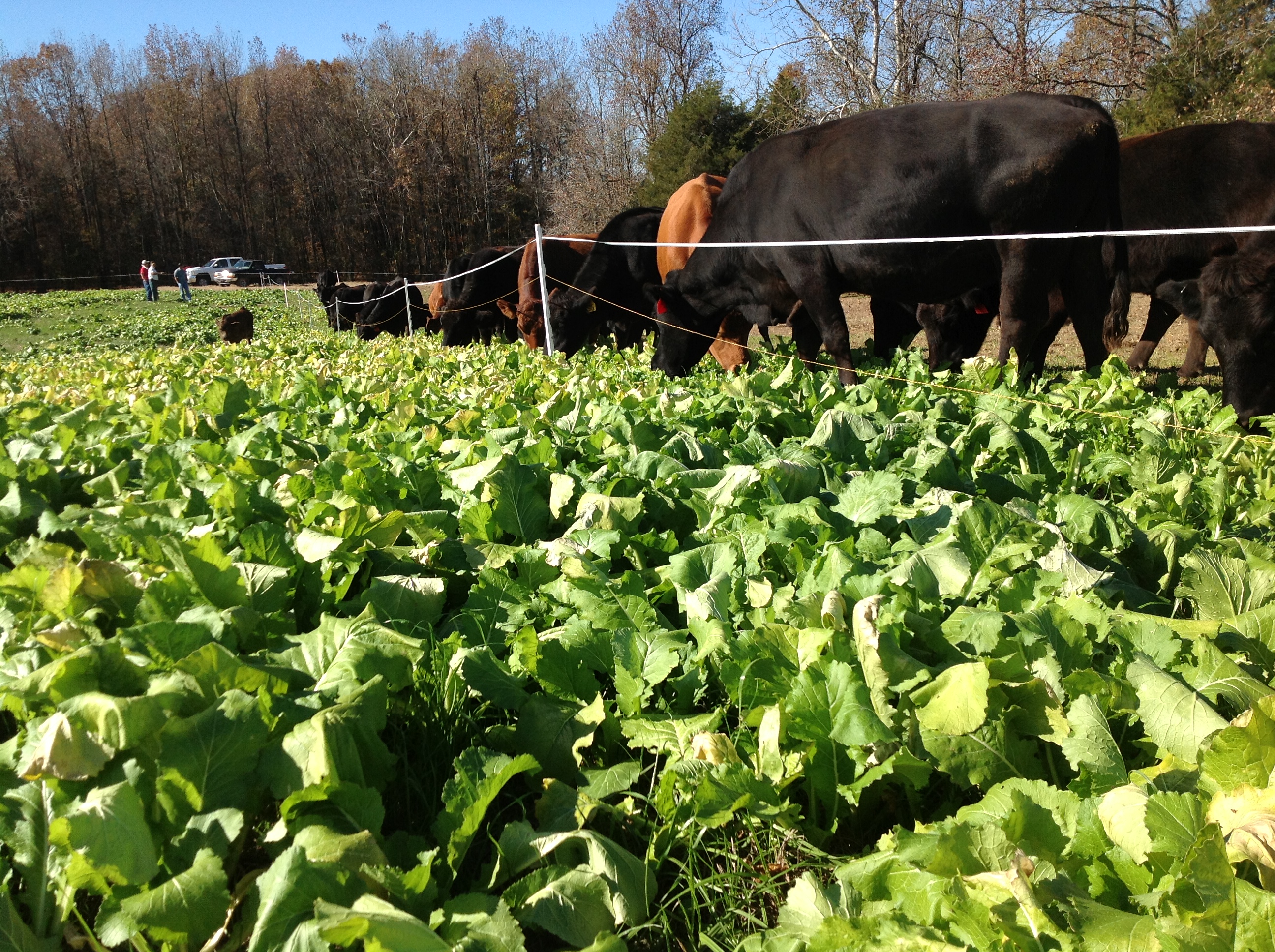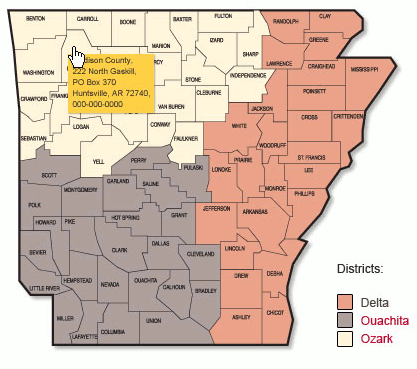Arkansas Grazing Management

Limit Grazing Forage Brassica - Lawrence County, AR
Most of the diet of cattle, horses, and small ruminants comes from forages. Managing pastures to provide quality forage in sufficient amounts to feed a herd during each season can be challenging.
Stocking rate and grazing methods strongly influence the amount of forage and hay needed. Extending the grazing season has a strong positive impact on profitability of livestock operations. Most producers grow adequate forage yield for their livestock, but management is focused on producing hay for a long hay feeding season instead of producing more lower-cost grazing days.
In Arkansas livestock producers rely heavily on hay and other stored feed during winter and struggle during summer drought to provide enough forage for their herds.
The winter hay feeding season for many producers is about 135 days. A good goal for livestock producers is to graze at least 300 days per year with a hay feeding season of about two months or less. That can be accomplished with proper stocking rates and advance planning. Continually planning forage management practices at least one season ahead makes a big difference in maintaining forage availability during the year.
Arkansas 300 Days Grazing System - Tips on Getting Started

Controlled Grazing with electric fence improves forage utilization. The first steps to 300 Day Grazing management.
The Arkansas 300 Days Grazing program has helped many producers improve their forage systems. The program includes eight different management practices to help reduce hay feeding and to extend the grazing season. To date, 146 demonstrations were conducted on farms in 50 counties. Direct savings to those producers totaled over $283,000. Demonstrations included as few as 5 head and as many as 500 head for a single farm. This emphasizes that the program fits small and large operations. Successful demonstrations were also conducted for horses and small ruminants confirming that the program fits well for all segments of the livestock industry.
Producers may not always achieve a grazing season of 300 days during their first year, but each practice adopted helps them get closer to that goal. Getting started is often the biggest hurdle faced by producers. The program employs a simple five-step process can work with any forage base and helps focus efforts toward the practices that can have the most impact with the existing forage. The key is to start with the existing forage base and plan at least one season ahead to ensure timely implementation of practices.
Five Steps for a 300 Day Grazing Season
-
-
- Inventory the forage base to find what forages are available for grazing during each season.
- Improve forage management practices to extend the grazing season with the existing forages (do this before adding any other forages).
- Add complementary forages to fill in seasonal gaps if needed. Plan short term and long-term options.
- Plan forage and grazing practices ahead for the year and get the schedule on the calendar.
- Monitor and adjust forages and livestock as needed by keeping records of each practice.
-
1. Inventory the forage base to find what forages are available for each season
Key points in conducting an inventory:
-
-
- What forages and acreage of each are available for grazing in spring, summer, fall, and winter?
- When does the typical winter hay feeding start and end? Is hay feeding needed during drought?
- What level of grazing management is being used?
- Is hay stored and fed in a manner to reduce waste?
- Is soil testing used and, if so, what is the fertility level for each pasture and hayfield?
- Are weed problems significant during any particular season?
- What is the overall farm stocking rate – how many grazing acres per animal unit?
- Also note the number and size of existing pastures and livestock access to water for each.
-
2. Improve forage management practices to extend the grazing season with the existing forages (do this before adding any other forages)
Two management practices that can extend the grazing season of existing forages are rotational grazing and stockpiling forages for fall and winter grazing. Rotational grazing can extend the grazing season during stress growing periods and can protect standing forage for grazing during dry periods. Rotational grazing can often be started effectively by closing gates to existing pastures. As the operator gains experience and confidence, more subdivisions can be added with temporary electrified polywire to provide more control of the grazing herd. This approach retains flexibility in the system for changing weather, herd size or management, or even for planning enough grazing during your vacation.
Stockpiling forages is a very effective and consistent method for providing fall and winter grazing. Many forages work well for stockpiling, but the best are probably tall fescue or bermudagrass. Other forages could work well based on regional experience and conditions. By adding both rotational grazing and stockpiled forages, the producer can gain several weeks to several months of grazing, all with the existing forage base.
Serious weed problems should be controlled before legumes are planted. Some weeds are useful as forage and are easily controlled with grazing. However, some weeds are not palatable for grazing or cannot be controlled by mowing so judicious herbicide application along with other practices should be considered.
Fertilizer application should be targeted to produce only enough forage for each season. For example, pastures with significant legume content do not need N fertilizer in spring. Pastures intended for stockpiling for winter need N for the stockpiling period. Applying too much fertilizer at one time creates excess growth which is either wasted or is cut for hay – both cases are contrary to the goal of a longer grazing season. Using soil tests to determine the base soil fertility is as important as knowing the base forage species growing in the pasture. In general legumes need higher soil fertility that grasses. Grazing does not increase soil fertility. Adding nutrients from outside sources is the only way to build fertility. Added nutrients can be from fertilizer, purchased feed, or hay or animal manure from off farm sources.
3. Add complementary forages to fill in seasonal gaps if needed
The next step after optimizing use of the existing forage base is to add any additional forage species that would complement that forage base. Complementary forages add grazing days or quality to the forage base instead of simply substituting for forage already being produced. For example, planting ryegrass on bermudagrass pasture adds spring grazing in that pasture that was not produced previously. Complementary forages that could be easily established into fescue in the short-term are legumes, such as clover and annual lespedeza, and crabgrass. Use of dedicated annual pastures to take pressure off native range during key periods could be considered. Perennial forage options can be part of the long-term plan. Use of rotational grazing will help maintain the mixtures and seasonal productivity.
4. Plan forage and grazing practices ahead for the year and get the schedule on the calendar
The key to a longer grazing season is to "always plan at least one season ahead". When planning a seasonal grazing system, the schedule for most forage practices can be put on a calendar to help keep management done on a timely basis. These include grazing practices, planting periods for complementary forages, stockpiling, and other forage management practices.
5. Monitor and adjust forages and livestock as needed by keeping records of each practice
Record keeping of the success and challenges associated with different forage management practices are important. Records provide a good basis for fine-tuning the system and for maintaining the most effective practices. Records can be simple notations on a calendar or can be more detailed analysis kept in a logbook or computer.
 |
 |
 |
| Like us on Facebook! |
|